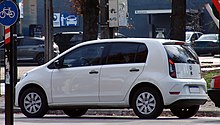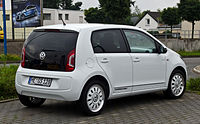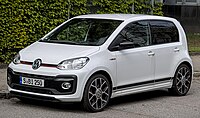
A | B | C | D | E | F | G | H | CH | I | J | K | L | M | N | O | P | Q | R | S | T | U | V | W | X | Y | Z | 0 | 1 | 2 | 3 | 4 | 5 | 6 | 7 | 8 | 9
| Volkswagen up! | |
|---|---|
 Volkswagen up! 5-door (pre-facelift) | |
| Overview | |
| Manufacturer | Volkswagen |
| Also called | Škoda Citigo SEAT Mii |
| Production | |
| Assembly |
|
| Designer | Klaus Bischoff, Oliver Stefani and Marco Antonio Pavone[4] |
| Body and chassis | |
| Class | City car (A) |
| Body style | 3-door hatchback 5-door hatchback |
| Layout | Front-engine, front-wheel-drive |
| Platform | Volkswagen Group NSF[5] |
| Powertrain | |
| Engine | |
| Electric motor | Permanent magnet synchronous motor |
| Transmission | 6-speed manual 5-speed manual 5-speed ASG automated manual 1-speed fixed gear ratio (electric) |
| Dimensions | |
| Wheelbase | 2,420 mm (95.3 in)[7] |
| Length | 3,540–3,563 mm (139.4–140.3 in)[7] |
| Width | 1,641 mm (64.6 in)[7] |
| Height | 1,478–1,489 mm (58.2–58.6 in)[7] |
| Kerb weight | 929–997 kg (2,048–2,198 lb)[7] |
| Chronology | |
| Predecessor | Volkswagen Fox SEAT Arosa |
The Volkswagen Up (stylized as Volkswagen up!) is a city car produced by the Volkswagen Group from 2011 to 2023. It was unveiled at the 2011 International Motor Show Germany (IAA).[8] Production of the Up started with the model year of 2012, in December 2011 at the Volkswagen Plant in Bratislava, Slovakia.[9] It is part of the New Small Family (NSF) series of models, alongside the SEAT Mii and Škoda Citigo which are rebadged versions of the Up, with slightly different front and rear fascias. The SEAT and Škoda versions were manufactured in the same factory,[10] before being withdrawn from sale in 2021 and 2020 respectively. Production of the Up ended in October 2023.[11] A battery electric version, called E-up, was launched in autumn 2013.
Overview
Pre-production
The production Up follows a series of concept cars, starting in 2007 at the Frankfurt Motor Show.[12] The exterior was originally designed by the Brazilian designer Marco Pavone.[13][14] This design was chosen and enhanced by Volkswagen Group Chief Designer Walter de'Silva, and Head Designer of the Volkswagen Passenger Cars marque, Klaus Zyciora. Shown at the Frankfurt launch were several further Up concepts, including a 98 hp (73 kW) GT version, a natural gas-powered Eco-up! (with CO2 emissions of 79 g/km) and a four-door Cross model.[8]
Where the Up concept used a rear-engine, rear-wheel drive layout, the 2011 production model has a front-engine, front-wheel drive layout, using the NSF platform,[5] with a 3-cylinder 1.0-litre petrol engine.[15]
It was originally reported that the Up concept would be produced under the name Lupo, like the Volkswagen Lupo that was discontinued in 2005.[16][17] Eventually this plan changed and the 2011 production model was named the Up.
Production version
At the International Motor Show Germany in 2011, Volkswagen unveiled the final version of the Up based on the Volkswagen New Small Family (NSF) modular architecture.[5] The three-door bodywork is inspired by the 2007 concept Up, the engine range is 1.0-litre three-cylinder gasoline 60 hp (45 kW) and 75 hp (56 kW). Both the three and five doors are available with engines running on CNG and called eco-Up. The Up is a front-wheel drive with transverse engine mated to a five-speed manual gearbox and is 3.54 metres (139 in) long has a wheelbase of 2.42 m (95 in). The cabin is configured to four or five seats.
The Up range included the Up GTI, which was previewed by the GT Up concept. Released in January 2018, the Up GTI feature a turbocharged version of the 1.0-litre three-cylinder engine producing 115 PS (113 bhp; 85 kW).[18][19] An electric hybrid Up — which would be badged Blue-e-motion — was planned for 2014 but never released.[20][21]
Along with the other two rebadged models, Up is the first car in its class to offer an automated braking system, called City Emergency Braking. The system is automatically activated at speeds below 30 km/h (19 mph), when a laser sensor identifies a danger of collision and activates the brakes. In the SEAT model, the system is marketed as the City Safety Assist and in the Škoda model it is called City Safe Drive.[22][21]
The Up won the 2012 World Car of the Year.
-
Rear view (3-door)
-
Rear view (5-door)
-
Interior
Marketing

The Up! is available to order in the United Kingdom since October 2011 for five models – marketed as Take Up, Move Up, High Up, Up Black and Up White.[23] British television show Top Gear presenters mocked the unusual name by calling the model "Up-exclamation-mark".[24]
The Up was introduced on the German market on 3 December 2011. Deliveries to other European markets began in April 2012.[citation needed]
In 2013, Volkswagen introduced the cross up! model, which has 15 mm more ground clearance than the standard model, and comes with plastic side skirts and wheel-arch flares as standard.[25]
In 2014, at the Geneva Motor Show, Seat presented the 2014 Seat Mii by Mango model aimed towards women, made in collaboration with the Spanish fashion company Mango.[26]
The SEAT Mii limited production started in October 2011 for the European market, with sales having started at the end of 2011. The final version was launched in May 2012.
The Up was sold in Australia until 2015, when it was withdrawn due to slow sales. Plans for the Škoda Citigo to be sold in Australia were also shelved.
At the Geneva Motor Show in 2016, the model sold in Europe received a facelift and the new TSI engine, that went on sale in the summer the same year.[27]
The Up was not sold in North America, CIS countries, Middle East, India,[28] China, South Korea, and Southeast Asia. Japanese sales began in October 2012. Due to its small size, the Up was one of Volkswagen's successful introduction in Japan.[29] The Up was also launched in South Africa in March 2015. Two models were offered at launch, both are the 1.0-litre 55 kW three-door variant. The two local options were marketed as Take Up, and the Move Up.[30]
Latin America

In February 2014, Volkswagen introduced a modified version of the Up for Latin America. Built in Brazil, the Latin American Up differs from its European counterpart in length (it is 65 mm (2.6 in) longer), thanks to revisions to the floorpan's rear section to accommodate a larger fuel tank (50 L instead of Europe's 35 L), a full-sized spare wheel and increased cargo space. All versions have revised tailgates with a painted metal section (like the Seat Mii's and Škoda Citigo's) instead of the dark glass trim used in Europe. The five-door Brazilian Up also uses a different rear door design with sectioned glass and wind-down windows. The South American model retains the European version's safety levels with a five-star crash rating[31] and ample use of high-strength steel elements.[32]
In July 2015, Volkswagen introduced a new powertrain for the Up sold in Brazil, using a 1.0-litre, direct fuel injection three-cylinder turbocharged engine.[33]
Up GTI
In mid-December 2016, Volkswagen presented the Up GTI. It is powered by a 1.0-litre three-cylinder TSI petrol engine, which produces 115 PS (113 bhp; 85 kW). Its top speed is 192 km/h (119 mph) and it is capable of accelerating 0–100 km/h (0–62 mph) in 8.8 seconds with a top speed of 196 km/h (122 mph). Weighing just 997 kg (2,198 lb), Volkswagen claims that it is capable of delivering between 49.6 mpg‑imp (5.7 L/100 km; 17.6 km/L) to 50.4 mpg‑imp (5.6 L/100 km; 17.8 km/L) depending on the specifications, with CO2 emissions between 127 and 129 g/km. It is the only Up to be available with a six-speed manual gearbox. The Up GTI went on sale in January 2018.[34]
In April 2019, ordering for the Up GTI was halted in the United Kingdom, but in January 2020 VW UK started taking orders again for a lightly refreshed version. The refresh included small optional equipment changes, but no alterations to the powertrain, chassis or brakes. As of January 2023, new orders for the Up GTI were closed to allow time to complete orders before the GTI model ceased production.
-
Up GTI
-
Rear view
-
Interior
E-up
First iteration
In July 2010 VW announced the production version of the E-up electric car, with sales scheduled to begin in 2013,[35] and was subsequently unveiled at the September 2013 International Motor Show Germany.[36][needs update]
The production version has an 18.7 kWh lithium-ion battery able to deliver 160 km (99 miles) on the NEDC cycle, can accelerate from 0-62 mph (100 km/h) in 12.4 seconds[37] and has a top speed of 130 km/h (81 mph). The E-up can be charged with 2.3 kW plugged into any standard 230 V socket, with 3.6 kW via a home-installed wall box or with up to 40 kW plugged into a DC fast-charging station via the optional Combined Charging System (CCS), which allows the battery to charge up to 80% in under 30 minutes.[38] The production version has the same dimensions as the five-door petrol model with seating for four.[39][40]
-
2012 e-Up
-
Powertrain bay
Second iteration
A second iteration of the e-up was announced on 5 September 2019. It is equipped with a larger 32.3 kWh battery, a range of 260 km (160 mi) and efficiency of 12.7 kWh/100 km (4.89 mi/kWh).[41] 32.3 kWh is the usable (net) capacity, while the total (gross) capacity is 36.8 kWh.
The Škoda version was released as the Škoda Citigo-e iV, with a 36.8 kWh battery capacity and a range of 270 km (165 miles) under WLTP standard, and was mass-produced from autumn 2019. It is the first all-electric car of Škoda Auto and replaced the combustion engine version. Similarly, the petrol-powered Seat Mii was replaced with an electric version, the Mii Electric.[42][43]
-
2021 e-Up
-
Rear view
-
Škoda Citigo-e iV
-
SEAT Mii Electric
Sales and market
| Year | Sales (% change from prior year) |
|---|---|
| 2013 | 940
|
| 2014 | 5,838(+621%)
|
| 2015 | 2,976(-49%)
|
| 2016 | 2,576(-13%)
|
| 2017 | 3,054(+19%)
|
Retail deliveries began in Germany in October 2013, followed shortly after by Denmark, Sweden, France, Norway, and the Netherlands, and the UK at the end of January 2014.[49][38] The E-up! is not sold in the U.S. or Canada.[50]
As of January 2020, Volkswagen have sold 21,000 E-up! Worldwide.[51]
Technical data
| e-up! (2013)[52] | e-up! (2019) | ||||
|---|---|---|---|---|---|
| Introduced | 2013 | 2019 | |||
| Transmission | Single-speed fixed gear ratio (electric) | ||||
| Power | 60 kW (80 hp) | ||||
| Torque | 210 N⋅m (150 lbf⋅ft) | ||||
| Battery | 18,7kWh (16.8 net) | 36,8kWh (32.3 net) | |||
| Range | 160 km (99 mi) | 258 km (160 mi) | |||
| Average Energy consumption | 11.7 kWh/100 km (NEDC) | 14.9 kWh/100 km | |||
| Drag coefficient Cd | 0.281 | 0.308 | |||
| charge time AC | 9 h (3,3 kW) | 5,5 h (7,1 kW) | |||
| charge time DC | 0.5 h (40 kW) | 0.75 h (40 kW) | |||
| 0–100 km/h
(62 mph) |
12.4 sec | ||||
| Curb weight
All fluids, 50% fuel |
1,139 kg (2,511 lb) | 1,229 kg (2,709 lb) | |||
| Top speed | 130 km/h | ||||
| Dimensions (length/width/height in mm): |
3540/1645/1477mm | 3600/1645/1492mm | |||
| Base price | €26,900 | €21,975 | |||
Powertrain
Both engines are also available with BlueMotion technologies (SEAT: Ecomotive, Škoda: Green Tech), which incorporates a start-stop system and regenerative brakes to reduce carbon emissions. Depending on markets, some 60PS and 75PS models are available with optional five-speed automatic transmission.
| Version | 1.0 (60 PS) | 1.0 (75 PS) | 1.0 (90 PS) | 1.0 (101 PS) | 1.0 (115 PS) | ||
|---|---|---|---|---|---|---|---|
| Type and number of cylinders | Straight-three engine with multi-point fuel-injection | Straight-three turbocharged engine with direct fuel-injection | Straight-three high-pressure turbo engine with direct fuel-injection | ||||
| Valves | 12 | ||||||
| Displacement | 999 cc (1 L; 61 cu in) | ||||||
| Power | 44 kW (60 PS; 59 hp) @ 5,000 rpm | 55 kW (75 PS; 74 hp) @ 6,200 rpm | 66 kW (90 PS; 89 hp) @ 5,000–5,500 rpm | 75 kW (102 PS; 101 hp) @ 5,000 rpm | 85 kW (116 PS; 114 hp) @ 5,000 rpm | ||
| Torque | 95 N⋅m (70 lbf⋅ft) @ 3,000–4,300 rpm | 160 N⋅m (118 lbf⋅ft) @ 1,500–3,000 rpm | 164.5 N⋅m (121 lbf⋅ft) @ 1,500 rpm | 200 N⋅m (148 lbf⋅ft) @ 2000 rpm | |||
| Transmission, standard | 5-speed manual | 6-speed manual | |||||
| Transmission, optional | 5-speed automatically shifted manual gearbox (ASG gearbox) | None | |||||
| Top speed | 161 km/h (100 mph) | 171 km/h (106 mph) | 185 km/h (115 mph) | 184 km/h (114 mph) | 192 km/h (119 mph) | ||
| Acceleration, 0–100 km/h (0-62 mph) | 14.4 seconds | 13.2 seconds | 9.9 seconds | 9.1 seconds | 8.8 seconds | ||
| Fuel consumption (combined, EU-norm) |
4.5 L/100 km (63 mpg‑imp; 52 mpg‑US) | 4.7 L/100 km (60 mpg‑imp; 50 mpg‑US) | 4.4 L/100 km (64 mpg‑imp; 53 mpg‑US) | ||||
| CO2 emission, combined (g/km) | 105 (BlueMotion 96) | 108 (BlueMotion 98) | 101 | ||||
| European emission standards | Euro 5 | Euro 6 | |||||
Safety
Latin NCAP
In 2014, the Latin-American Volkswagen Up was evaluated under the Latin NCAP assessment and achieved a 5-star security rating for adults and 4-star security rating for children:[53]
| Test | Score | Points |
|---|---|---|
| Adult | 93.29% (5-star) | 15.86 out of 17 |
| Children | 80.69% (4-star) | 39.54 out of 49 |
Euro NCAP
2011
In 2011, the SEAT Mii was evaluated for its safety performance under the Euro NCAP assessment scheme and it achieved a 5-star overall rating:[54]
| Test | Points | % |
|---|---|---|
| Overall: | ||
| Adult occupant: | 32 | 89% |
| Child occupant: | 39 | 80% |
| Pedestrian: | 17 | 46% |
| Safety assist: | 6 | 86% |
2019
The CITIGO in its standard European market configuration received 3 stars from Euro NCAP in 2019.[55]
The up! in its standard European market configuration received 3 stars from Euro NCAP in 2019.[56]
The Mii in its standard European market configuration received 3 stars from Euro NCAP in 2019.[57]
Environmental performance
In February 2019 Green NCAP assessed Volkswagen Up GTI with 1.0-litre TSI engine and 6-speed manual gearbox:












